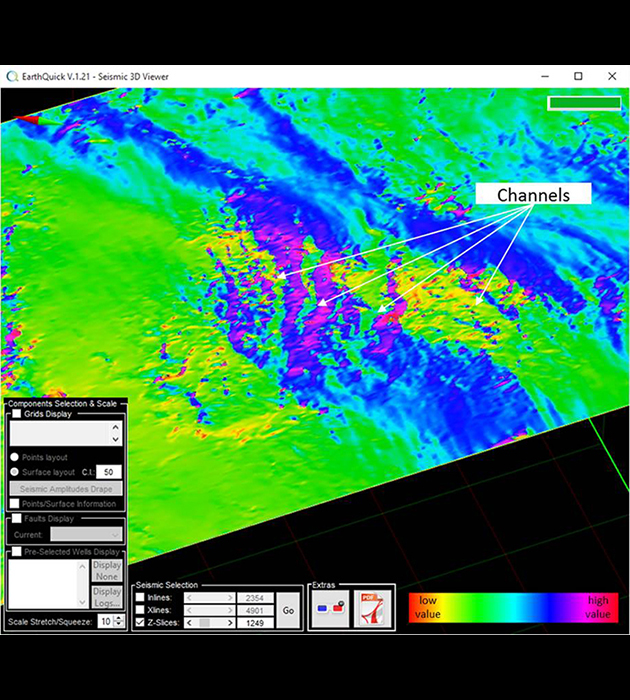-
Step 1: Dip and Azimuth fundamentals.
The opposite panel gives an overview of the attributes characteristics.
-
Step 2: Case Study Overview.
Discussion only focuses on signal processing matters. Neither Interpretation nor geological concepts are developed. However, to deal with concrete matters, example with depositional channels occurrence has been taken. Improvement with channels edges detection shall be discussed.
The seismic data is extracted from pre-stack time migrated 3D seismic data (New Zealand, Parihaka Block).
- On the left-hand side, the base map shows an interpretation horizon, picked as a cap of a channels system, with dip attribute extracted along the latter and overlapped as a transparent layer. The dark red line locates the current crossline 4763.
- On the right-hand side, the current crossline 4763 of the reflected amplitudes cube is focused on the channels system. Green picking represents intersection between the interpretation horizon on the base map and the crossline.
- The double white arrows link channel occurrence between the base map and the seismic.
- The dip attribute exhibits several meandering features. Same channels system shall be tracked from step 3 to step 6 to compare time-slice and horizon-slice benefits when dealing with dip and azimuth attributes.
-
Step 3: Time slice with the Dip attribute.
The 1252-ms time slice is extracted from the dip attribute. That flat surface collect dip values by cutting through the meandering system.
-
Step 4: Horizon slice with the Dip attribute.
Dip attribute is extracted along and draped over the same horizon as mentioned in step 2.
Depositional channels occurrence is better highlighted than in step 3.
-
Step 5: Time slice with the Azimuth attribute.
Same as in step 3 with Azimuth.
-
Step 6: Horizon slice with the Azimuth attribute.
Same as in step 4 with Azimuth.
Channels edges are much better observed with the use of the horizon slice display.
As a general rule, benefits of horizon slice compared to a constant time slice is obvious to track features which does not intrinsically occur at constant time or depth.
Acknowledgements:
The example is made of anisotropic Kirchhoff pre-stack time migrated 3D seismic data (New Zealand, Parihaka Block) provided by New Zealand Petroleum and Minerals (NZPM). NZPM and New Zealand Government are kindly acknowledged for making data public if dedicated to academic purposes.











